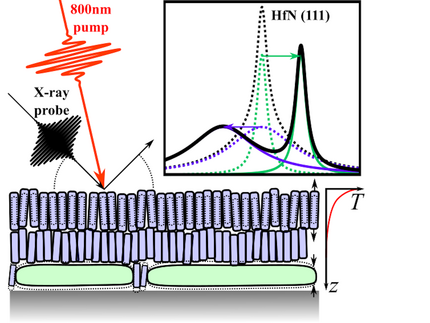Advancing ultrafast techniques
We constantly develop techniques related to ultrashort laser pulse phenomena:
For example, x-ray methods such as ultrafast x-ray diffraction (UXRD), reciprocal space mapping (RSM) and reciprocal space slicing (RSS). X-ray scattering experiments are performed both at the laser-based plasma x-ray source (PXS) and at large scale facilities – in particular the KMC3-XPP beamline at BESSYII @ HZB. Recently, we extended the PXS setup with time-resolved magneto-optical Kerr effect (MOKE) detection.
We have developed noncollinear optical parametric amplifiers, broadband time-domain Brillouin scattering and MOKE setups. We also apply Raman scattering, transient absorption and transient reflection spectroscopy.
In collaboration with the Peter Gaal group (IKZ Berlin) we developed a highly compact transient laser grating setup dedicated for usage at synchrotron beamlines which also facilitates coherent-control schemes.
Please visit the techniques section for more details.
Related publications
S. P. Zeuschner, J.-E. Pudell, M. Mattern, M. Rössle, M. Herzog, A. Baldi, S.H. C. Askes, M. Bargheer
Unveiling the Nanomorphology of HfN thin Films by Ultrafast Reciprocal Space Mapping
Advanced Optical Materials 12, 2400939 (2024).
Hafnium Nitride (HfN) is a promising and very robust alternative to gold for applications of nanoscale metals. Details of the nanomorphology related to variations in strain states and optical properties can be crucial for applications in nanophotonics and plasmon-assisted chemistry. Ultrafast reciprocal space mapping (URSM) with hard X-rays is used to unveil the nanomorphology of thin HfN films. Static high-resolution X-ray diffraction reveals a twofold composition of the thin films being separated into regions with identical lattice constant and similar out-of-plane but hugely different in-plane coherence lengths. URSM upon femtosecond laser excitation reveals different transient strain dynamics for the two respective Bragg peak components. This unambiguously locates the longer in-plane coherence length in the first 15 nm of the thin film adjacent to the substrate. The transient shift of the broad diffraction peak displays the strain dynamics of the entire film, implying that the near-substrate region hosts nanocrystallites with small and large coherence length, whereas the upper part of the film grows in small columnar grains. The results illustrate that URSM is a suitable technique for non-destructive and depth-resolved investigations of the morphology of nanostructures.
Rössle M., Leitenberger W., Reinhardt M., Koç A., Pudell J.-E., Kwamen C., and Bargheer M.
The time-resolved hard X-ray diffraction endstation KMC-3 XPP at BESSY II
Journal of Synchrotron Radiation 28, 1 (2021).
The time-resolved hard X-ray diffraction endstation KMC-3 XPP for optical pump/X-ray probe experiments at the electron storage ring BESSY II is dedicated to investigating the structural response of thin film samples and heterostructures after their excitation with ultrashort laser pulses and/or electric field pulses. It enables experiments with access to symmetric and asymmetric Bragg reflections via a four-circle diffractometer and it is possible to keep the sample in high vacuum and vary the sample temperature between ∼15 K and 350 K. The femtosecond laser system permanently installed at the beamline allows for optical excitation of the sample at 1028 nm. A non-linear optical setup enables the sample excitation also at 514 nm and 343 nm. A time-resolution of 17 ps is achieved with the `low-α' operation mode of the storage ring and an electronic variation of the delay between optical pump and hard X-ray probe pulse conveniently accesses picosecond to microsecond timescales. Direct time-resolved detection of the diffracted hard X-ray synchrotron pulses use a gated area pixel detector or a fast point detector in single photon counting mode. The range of experiments that are reliably conducted at the endstation and that detect structural dynamics of samples excited by laser pulses or electric fields are presented.
Schmidt D., Bauer R., Chung S., Novikov D., Sander M., Pudell J.-E., Herzog M., Pfuetzenreuter D., Schwarzkopf J., Chernikov R., and Gaal P.
A new concept for temporal gating of synchrotron X-ray pulses
Journal of Synchrotron Radiation 28 (2021).
A new concept for temporal gating of synchrotron X-ray pulses based on laser-induced thermal transient gratings is presented. First experimental tests of the concept yield a diffraction efficiency of 0.18%; however, the calculations indicate a theoretical efficiency and contrast of >30% and 10^(−5), respectively. The full efficiency of the pulse picker has not been reached yet due to a long-range thermal deformation of the sample after absorption of the excitation laser. This method can be implemented in a broad spectral range (100 eV to 20 keV) and is only minimally invasive to an existing setup.
Zeuschner S. P., Mattern M., Pudell J.-E., Reppert A. v., Rössle M., Leitenberger W., Schwarzkopf J., Boschker J. E., Herzog M., and Bargheer M.
Reciprocal space slicing: A time-efficient approach to femtosecond x-ray diffraction
Structural Dynamics 8, 014302 (2021).
An experimental technique that allows faster assessment of out-of-plane strain dynamics of thin film heterostructures via x-ray diffraction is presented. In contrast to conventional high-speed reciprocal space-mapping setups, our approach reduces the measurement time drastically due to a fixed measurement geometry with a position-sensitive detector. This means that neither the incident (ω) nor the exit (2θ) diffraction angle is scanned during the strain assessment via x-ray diffraction. Shifts of diffraction peaks on the fixed x-ray area detector originate from an out-of-plane strain within the sample. Quantitative strain assessment requires the determination of a factor relating the observed shift to the change in the reciprocal lattice vector. The factor depends only on the widths of the peak along certain directions in reciprocal space, the diffraction angle of the studied reflection, and the resolution of the instrumental setup. We provide a full theoretical explanation and exemplify the concept with picosecond strain dynamics of a thin layer of NbO2.





